
Non-alcoholic fatty liver disease (NAFLD) is a long-lasting condition that is caused by a build-up of fat in the liver.
The vital organ is responsible for more than 500 functions, including converting food into energy and removing toxins from the blood. Any problems with the liver, therefore, can be dangerous.
A healthy liver should contain little or no fat, but the British Liver Trust warns that NAFLD affects up to one in five people in the UK.
As the name suggests, NAFLD is not caused by alcohol, it is often linked to obesity and having type 2 diabetes.
In its earliest stages it often doesn’t display symptoms making it hard to catch.
 Hospitals run out of oxygen and mortuaries full amid NHS chaos
Hospitals run out of oxygen and mortuaries full amid NHS chaos
However, if it progresses it can reach the fourth and most severe stage, known as cirrhosis, which occurs after years of inflammation.
Every year over 4,000 people in the UK die from cirrhosis, which causes the liver to become shrunken, scarred and lumpy.
The NHS says: “This damage is permanent and can lead to liver failure (where your liver stops working properly) and liver cancer.”
If someone has cirrhosis they are more likely to experience symptoms, such as loss of appetite.
Want to get the latest health news direct to your inbox? Sign up for the Mirror Health newsletter
 NAFLD is often linked to being overweight and having type 2 diabetes (Getty Images/Science Photo Library RF)
NAFLD is often linked to being overweight and having type 2 diabetes (Getty Images/Science Photo Library RF)The British Liver Trust warns that staying well nourished can be difficult if you have cirrhosis due to several problems that can make eating unappealing.
These can include:
Loss of appetite
Feeling sick (nausea)
Being sick (vomiting)
 Mystic Mag's 2023 predictions include strikes, sleaze, self pity and separation
Mystic Mag's 2023 predictions include strikes, sleaze, self pity and separation
Pain or discomfort in your tummy or abdomen
Feeling tired (fatigue)
Anxiety
Depression.
If you are struggling with loss of appetite as a result of cirrhosis the trust recommends:
Eating small but frequent meals – little and often
Snacking if ‘proper meals’ are too difficult to eat
Trying to eat something every two hours, however small
Tempting yourself with foods you like
Not forcing yourself to eat food you don’t like
Trying to relax before and after you eat
Taking your time over eating – chew well and breathe steadily
Trying cold foods such as biscuits or sandwiches
Trying a nourishing drink if you don’t like solid food.
It adds: “Nourishing drinks include full cream milk, homemade fruit milkshakes or smoothies, and drinks made with nutritional supplements.
“Check with your doctor or dietitian before using nutritional supplements to find out if they are suitable for you.”
Other common symptoms of cirrhosis include:
Feeling very tired and weak
Losing weight and muscle mass
Red patches on your palms and small, spider-like blood vessels on your skin (spider angiomas) above waist level.
If cirrhosis gets worse it can cause:
Yellowing of the skin and whites of the eyes (jaundice)
Vomiting blood
Itchy skin
Dark pee and tarry-looking poo
Bleeding or bruising easily
Swollen legs (oedema) or tummy (ascites) from a build-up of fluid
Loss of sex drive (libido).
If you are experiencing symptoms of cirrhosis or fatty liver disease you are advised to see a GP.
To prevent getting or reduce the effects of fatty liver disease the NHS recommends adopting a healthy lifestyle, including:
Losing weight if you are overweight
Eating a healthy diet – high in fruits, vegetables, protein and carbohydrates, but low in fat, sugar and salt
Swapping sweet drinks for water
Exercising regularly
Quitting smoking.
Read more similar news:
Comments:
comments powered by Disqus





























